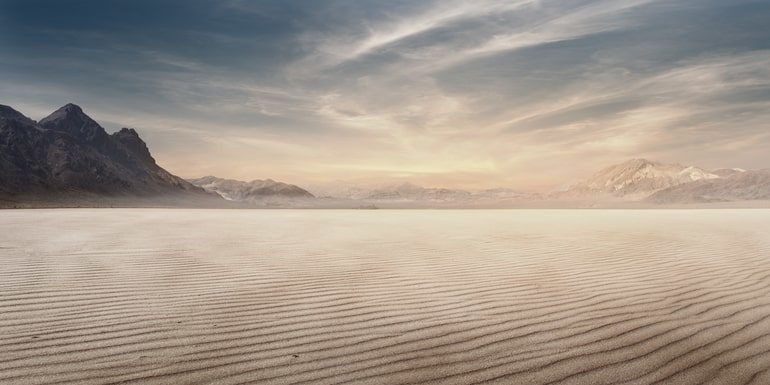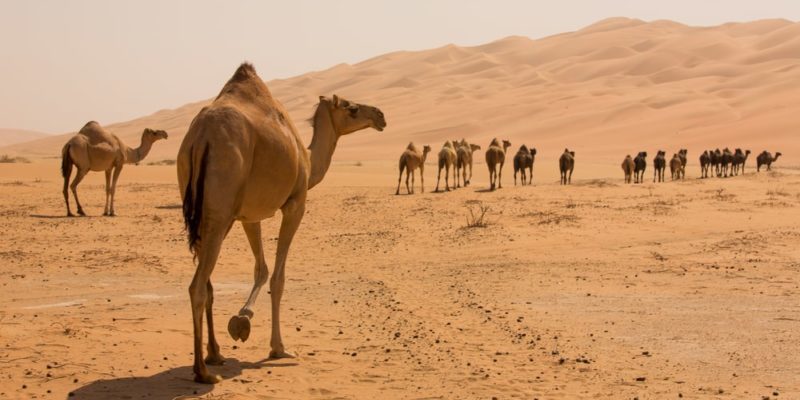The desert It is a type of biome that is characterized by extreme and variable temperatures, low rainfall and dry soils. There are hot deserts, formed by large areas of sand or rock, and cold deserts, formed by large areas of ice. For example: the Sahara desert in North Africa or the Antarctic desert in Antarctica.
This type of ecosystem It occupies a large portion of the earth’s surface and is present on all continents. The climate, flora and fauna vary according to the type of desert, although in almost all cases the rainfall does not exceed 250 mm per year and the species of animals and plants are adapted to the climate and the characteristics of the terrain. Deserts are places with little or no human settlement.

Desert climate
The desert climate varies according to the type of desert:
- Polar desert. The climate in the polar desert is characterized by very low temperatures, always below 10 ºC, and strong gusts of wind. Rainfall does not exceed 250 mm per year, so the climate is very dry. The two polar deserts of the world are in the Arctic and Antarctica.
- Hot desert. The climate in the hot desert is characterized by a great thermal amplitude: during the day the temperature can exceed 50 ºC while, at night, the temperature can drop below -10 ºC. Rainfall is almost nil and does not usually exceed 250 mm per year. These deserts have arid soils, intense solar radiation, and their constituent rivers remain dry for much of the year. For example: the Lut desert in Iran.
However, not all hot deserts have such extreme temperatures. In many cases, temperatures and rainfall can vary depending on geographic location. Some subtypes of hot desert are:
- Semi-arid zone or steppe. Average temperatures range from 20 to 27 ºC during the day and 10 ºC at night. This climate is found on the edges of deserts. For example: some areas of the Sonoran desert in North America.
- Coastal desert area. Average temperatures are usually between 13ºC and 14ºC. For example: the Atacama desert in Chile.
Desert flora
The desert flora it is very scarce and dispersed, since there are large areas of the ground covered with sand, rocks or ice (in the case of the cold desert).
Due to extreme conditions and at low rainfall, the plants that grow in the hot desert are xerophilic and have deep roots that allow them to find fertile soil to feed on. In addition, some species have water storage systems that allow them to withstand low rainfall.
In the hot deserts low grasses and isolated shrubs can be found, which vary according to the geographic location of the desert. Some of them are: nopales, succulents, mesquite, water biznagas, tumbleweeds, California poppies, bushes, deserti agaves, nopales, Jericho roses, hawthorn, Indian molt, goat horns, saltpeter herbs and cacti.
Many deserts have zones of oasis, which are small places with water and vegetation in which plant species such as palm trees and other shrubs emerge.
In cold deserts there is a sparse flora due to low temperatures and nutrient-deficient soils as a result of low rainfall. Some species are: the Antarctic grass, the Antarctic pearl, the polar willow, mosses, ferns and lichens.
Desert fauna

The warm desert fauna It is made up of small animals that can take refuge from high temperatures under sand, rocks or soil.
Reptiles such as snakes, chameleons, desert tortoises, and lizards can be found; and some small mammals such as foxes, gerbils, jackals, coyotes, mice, and desert meerkats. The large mammals that live in the desert are the camel and the dromedary.
In addition, there are insects such as ants, spiders, scorpions and birds such as hawks, vultures, the desert owl, the Sahara ostrich, the desert sparrow, among others.
At cold desert, the ice-covered surfaces and the lack of food mean that the communities of animals that live do so in the areas close to the coasts. Such is the case with penguins and polar bears, which spend much of their time at sea.
